Welcome back! Here's the second part of my Complete Introduction to Deckbuilding series, which dives into the practical details of putting a deck together and ensuring it runs smoothly. The first part, if you missed it, lives here.
This part contains five sections:
5. To Splash or Not To Splash?
6. Look at Everything
7. Don't Forget Removal
8. Stick to Sixty; Balancing Card Roles
9. Synergy
#5. To Splash or Not to Splash?
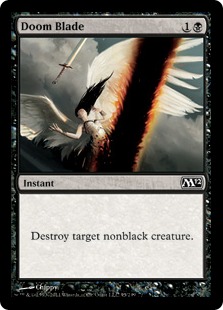
Yes.
Splashing has a lot of things going for it. It allows you to patch holes in a deck without moving away from its core colours too much, so your Lashwrithes and Bellowing Tanglewurms still do what they're supposed to do, and you can still reasonably expect to be able to summon colour-demanding cards like Angel of Jubilation. Whenever your deck has a hideous vulnerability you want to get rid of, think about splashing if your collection of stuff in the deck's main colours doesn't have a good answer.
Splashing does require care though. It's too easy to think, say, 'oh, this Curse of Exhaustion would be fantastic in a werewolf deck - I should splash white for it!', and end up with a bunch of Plains and a somewhat cumbersome enchantment in an otherwise red-green deck that's all about beating people about the face. When you're splashing, consider:

No.
- Will the splash actually *do* anything in most games? If you're unlikely to draw the cards you're splashing for, they're too situational, or they're not *that* necessary, there's not much point.
- Does my splash require too much mana my deck can't already generate? Splashing black for Falkenrath Noble is pretty practical in the right deck. It's a useful card that can have a huge impact on a game just by being there, and generating one black mana on turn 4-or-thereabouts is not a particularly steep requirement. Splashing black for Phyrexian Obliterator is... less so. Even cards that need only two of a colour, like Murder or Martial Law, are quite difficult to splash because getting them out is suddenly really unreliable.
- Will the splash hurt my deck too much? If you're suddenly exchanging a quarter of your lands for ones of the wrong colour, it's going to have a fairly significant detrimental effect on the consistency of the rest of the deck. If you draw a load of splash-coloured lands near the beginning of the game, you may end up frustratingly unable to cast the deck's pivotal cards.
There are ways, of course, to increase the efficiency of splashing. All that mana-fixing stuff I talked about in the previous section is perfect. Drawing extra cards also helps a lot. The less likely you are to wind up drawing splash-mana-generating cards when you don't need or want them, the better. But, likewise, when you do need them, you want one nearby.
#6. Look at Everything
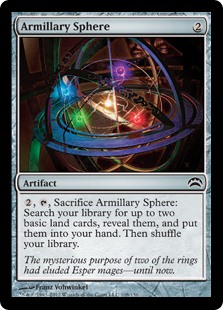
It's also worth finding a good layout for your cards when you're deckbuilding. I tend to lay them out in columns grouped by converted mana cost (the amount of mana you need to summon one), with separate columns for creature cards and non-creature cards, and the lands off to one side, grouped by type. This way, it's easy for me to see how much I have access to at any point on the mana curve, so I can guess at how the deck will develop as a game proceeds.
#7. Don't Forget Removal
The clue's in the title for this one. Any deck needs to be able to answer certain threats to it, and pretty much every deck will need an answer to creatures. Decks that rely on lots of ground creatures need to have some way of dealing with flyers; decks that rely on flyers need to be able to deal with enormous monsters. Quick decks need to clear blockers out of the way, slow decks need to answer offensive threats to buy themselves time, and every deck needs to be able to kill off enormous things. On top of that, tapping a couple of mana and slamming down an Ultimate Price on your opponent's Utvara Hellkite is gloriously satisfying. I can't overstate the importance of including removal; whenever I cut down on its presence in one of my decks, I always find myself staring down the barrel of something my deck just doesn't want to deal with - whether it's something as simple as a Seraph of Dawn, or an enormous bomb that can kill me in two turns, like Gisela, Blade of Goldnight.
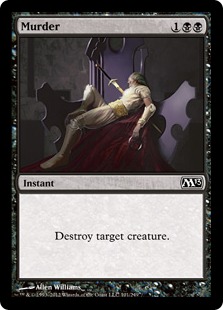
Each colour has its own answers. (Artifacts rarely do any sort of removal.) Here's a rough overview of what you can do.
Black: Black has the best creature removal in Magic. Black spells tend to say 'Destroy target creature' (which doesn't care how big it is) or 'Target creature gets -X/-X' (which can kill indestructible or regenerating creatures). If you're playing a predominantly black deck, you have a good choice of cheap creature-killers, from the simple-but-effective Murder and Doom Blade to the slightly bizarre Tragic Slip and Bone Splinters. Black does lack any sort of artifact or enchantment destruction, though, so watch out for that.
Red: Red has access to a lot of so-called "burn" spells, which deal some amount of damage to a target creature, player, or your choice of both. Searing Spear is the current 'basic burn' spell, but it's accompanied by such weapons as the Undying-hater Pillar of Flame, the versatile Flames of the Firebrand and the expensive, sometimes game-ending Thunderous Wrath. Red also has access to cards which damage or destroy every creature on the battlefield (referred to as "boardsweepers"), such as Slagstorm. Burn's strengths and weaknesses are obvious. Its ability to kill large creatures is limited, so if your opponent pulls a 6/6 out, you may have some issues. On the other hand, its ability to hit players is unique among the colours, and enables some very aggressive decks who can turn their removal on their opponents to add pressure or finish a game. Burn decks are a lot of fun to play, and seem quite common among new Magic players.
White: White has a lot of very good conditional removal, which is highly effective but tends to have a weakness that offsets its cost and power. It uses enchantments like Pacifism and Oblivion Ring, conditional 'revenge'/'punishment'-themed destroy spells like Smite the Monstrous and Condemn, and strong boardsweepers like Day of Judgment, which have the obvious downside of blowing up all of your stuff as well.

Blue: Blue's removal is much more abstract than that of the other colours. Blue doesn't destroy things, but bounces them to your opponent's hand (Unsummon or Aether Adept), taps them (Encrust or Sleep), prevents them from ever existing at all (Cancel or Essence Scatter), and that sort of thing. In general, timing is critical with blue removal. A well-placed Sleep or an overloaded Cyclonic Rift can win you a game or buy you time to recover from a very bad position, provided you do it at the right moment. Unsummoning something by itself is not hugely powerful, but if you do it when something horrible attacks you, to clear a blocker out of the way for a turn, or to disrupt your opponent's plans, it can be really quite useful; it can also save your own creatures from being destroyed or provide an antidote to inconvenient Giant Growths. Likewise, counterspells like Cancel require you to have the right mana available as your opponent casts her spell, which can limit casting your own. Using (or avoiding) counterspells well involves mindgames and trying to guess what's in your opponent's hand. Dropping a huge dragon against an opponent playing blue with three lands untapped is pretty risky, but conversely, leaving those three lands open is pretty expensive when it comes to your own summonings, and when your opponent (who, for the sake of this example, has seven lands) opens her turn with a Searing Spear aimed at one of your creatures, do you counter it to save your creature, or keep the counter for the other card in her hand, in case it's that Thundermaw Hellkite you know is in her deck? The answer can vary from game to game.

#8. Stick to Sixty; Balancing Card Roles
It always seems really hard, but always stick to 60 cards - resist the temptation to use more! This may seem almost pedantic; after all, the chances of drawing any given card in a 61- or 62-card deck aren't that much lower. They are lower, though, and it's surprisingly noticeable. Here are a few reasons why it's good to be stern and cut it down:
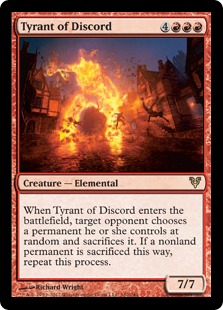
You probably don't want three
of these, for example.
- If you slip to 62, it's easy to slip to 65 once in a while, where the difference is bizarrely huge.
- Most of the time, when people include too many cards, they forget to up the land count to match, and end up getting mana-screwed a hell of a lot.
- Forcing yourself to cut cards will hone the final 60 to be the leanest and meanest of the lot.
- It maximises the chances of drawing one of your best cards, or the key cards of the deck; put another way, it's maximally efficient.
- It's good practice. This sounds like a stupid reason, but it isn't. Being strict with your 60-card limits gets you thinking about what the best cards for a given deck really are, and so increases your understanding of the game.
- Perhaps most subtly, it means that each card in your deck has a known chance of showing up. If all of your decks are the same size, you know that the 2 Righteous Blows in one deck have the same chance of being drawn as the 2 Shocks in another. Once you have a feel for how often a card shows up if you include one, two, three or four copies of it in your 60-card deck, you'll feel much more confident in deciding how many of a card you need.
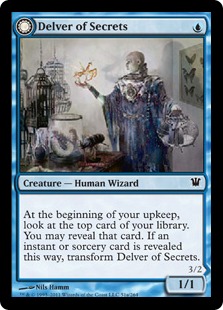
Four of these guys, on the
other hand...
- 1 copy: I can search my library for this in some way, or it's an expensive bomb suited to the late game, at which point I might have drawn it.
- 2 copies: This will come up a reasonable amount of the time, but I don't want more than one at a time, and ideally not in my opening hand.
- 3 copies: I want to draw one in every game.
- 4 copies: I want or need this card, and I'm more than happy to draw multiples of it or have it in my opening hand.
Personally, I'm not a huge believer in the 9x4 rule. It has its benefits - your deck will be consistent, predictable, and tight - but it belies the reality of many decks and the difficulty or unlikelihood of owning four copies of something (never mind nine somethings that work well together and form a close mana curve). However, there's a similar principle that's definitely worth sticking to: if you want your deck to be able to do something in particular, commit to it. Know how it fits in, be it a major win condition or a pair of Keening Apparitions you're using to deal with your mate's Pacifism spam. If it's a situational bomb or answer card, feel free to only include a couple, as above - but make sure you know the ramifications of that. If it's meant to be a core piece of your deck, make sure you can draw it reliably every time, by including lots of it, lots of cards like it, and/or ways to dig it out of your library or draw cards to ensure you get hold of it.

Take boardsweepers like this
only if you know you'll cast them.
For example, let's say I'm building a generalist black-green deck that's meant to be able to fight well at any point on the mana curve, but all my mana acceleration cards are in other decks. I decide that it's worth including some aggressive cards to attack my opponent straight out of the gate, a stable midrange that can engage big threats if my opponent pulls ahead of me in mana, and a couple of huge splashy bomb cards that'll swing the game in my favour if it goes long. As a substitute for my lack of ramping, I decide to make use of the Golgari scavenge mechanic, as seen on Sluiceway Scorpion. Armed with this knowledge, I decide I'll need kill spells, aggressive creatures, midrange creatures, bombs, and pump spells. I need lots of creatures, so I split up my deck this way:

An example bomb.
- Aggressive creatures: I want one or two in my opening hand, but let's not go overboard, since they have trouble against large threats. I'll take 8.
- Midrange creatures: These are the body of the deck, and will include decent fighters with scavenge and/or deathtouch. I need a good mix, for attacking or defending as I see fit. 12, please.
- Bombs: I'm tempted to say 4, but four bomb cards may well be too many. These guys are for the long game, and 6+ mana cards are dead draws until much later. I'll take two instead.
- Kill spells: Removal is awesome, but I don't want to go overboard on it. Still, I'm going to want to blow up two or three creatures in any given game. 6 kill spells sounds about right.
- Pump spells: These are situational, and often inferior to removal, but can turn a Dreg Mangler into a bomb for one turn every now and then, and keep an opponent on his toes. I'll take 2.
Adding these numbers up, I only get 34 - I have two card slots left over. I'll give them to the midrange creatures, upping them to a tasty 14. Now I can go about building the deck, with these proportions in mind, and despite only owning one Rakdos Cackler and nowhere near enough Vampire Nighthawks, I'll end up with a decently reliable deck anyway, provided I stick to the roles intelligently.
This pseudo-consistency also has a pleasing result in casual play. Decks made of four of everything may be super-tight and reliable, but they play in much the same way every game, which is actually a downside in some ways. For casual games, I like the increased variance of a deck with 2 of everything instead. That's not to say I don't use 4-ofs in my decks - of course I do, when I own enough cards - but I don't make it a goal to do nothing else, and there are cards I don't necessarily want to include four of anyway. Vampire Lacerator, for instance, is a great card, but I don't want to have two of them active at once. (It's since been superseded by Diregraf Ghoul, but I don't think I have any of those.)
#9. Synergy
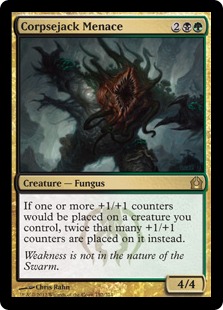
For instance, the aforementioned Corpsejack Menace by itself is just a 4/4 for four mana, which is reasonable, but nothing to write home about. However, if you cast Hunger of the Howlpack with the Menace out, suddenly your instant is twice as good as it was before. If you use a Sluiceway Scorpion's scavenge ability, you get four +1/+1 counters on your chosen creature instead of two. Suddenly, your once-basic 4/4 is making your other cards far better than they were before. If you happen to put Cathars' Crusade down, and then play a Mycoloth... should you care to run the maths, you'll find that in four turns that your Mycoloth has generated no less than 64 creatures, the smallest of which is a 43/43. Boom!
Corpsejack Menace exhibits what I'd call 'explicit' synergy - the card itself exists to improve other cards in a synergistic manner, and has a rule saying so. The Mycoloth/Cathars' Crusade combination, on the other hand, runs closer to what we might name 'hidden' or 'implicit' synergy. The cards themselves make no direct mention of one another, but it so happens that the Mycoloth generates creatures based on the number of +1/+1 counters on it and Cathars' Crusade generates +1/+1 counters based on the number of creatures entering the battlefield. There are endless synergies like this in Magic, and there's no way I or anyone else could ever list them all; in any case, discovering them is part of the fun!

Whenever you're deckbuilding, always keep an eye out for potential synergies. If a creature has an ability that triggers when it deals damage to a player, consider how you can make it harder to block; if a creature has an ability that relies on the amount of damage it deals, or makes its damage more potent (like double strike, lifelink or infect), think about ways to increase that damage. Likewise, if you have a card that explicitly improves other abilities (such as our good friend Corpsejack Menace, or Sanguine Bond), think about what else you have that it enhances. If you have a card whose abilities are not obviously powerful at first glance (like Ghave, Guru of Spores), consider what horrible things you could do to make them powerful.
Comments